© 2025 ALLCITY Network Inc.
All rights reserved.

A big part of our film rooms is to find if common perception is correct on a certain player or scheme. Another part is being able to establish if there’s some deceiving information in the statistics, and often film rooms can go against the evidence brought forth by conventional stats.
This one is a rare case in which the statistics and film are actually in agreement. The entire premise of this film breakdown is based on the fact that Case Keenum, while great on third down a year ago, was amongst the worst quarterbacks in the NFL on third-and-long.
Keenum was the NFL’s fifth-best quarterback on third down in 2017, converting over 45-percent of his attempts, which is a huge upgrade from what the Denver Broncos had a season ago. His numbers on third-and-short and third-and-medium were also great, ranking him amongst the league’s best.
Where things got tricky was on third-and-long—defined as 3rd-and-8 or more—where he was 29th in the league, converting only 18 percent of his 56 attempts for first downs. That figure ties him with Brock Osweiler a season ago, which isn’t exactly what fans in the Mile High City would like to hear.
With that premise in mind, with an emphasis on how the offensive line ties into it all, we dug into the film to see why Keenum struggled on third-and-long, while also trying to figure out what the Broncos offense around him needs to do for him to succeed.
Lack of arm strength or being risk averse?
Keenum’s arm isn’t the biggest. He’s also small in stature, and if you read our previous film breakdown on the Broncos’ new quarterback, it’s easy to see how his physical talent isn’t his best asset. Thus, it stands to reason that when he’s in a situation like third-and-long, where everyone in the stadium knows Keenum has to throw the ball downfield, he’s not at his best.
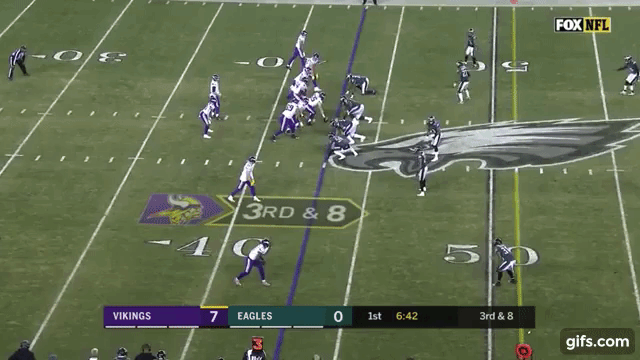
When watching the tape, Keenum was fairly efficient in shorter third downs, even taking a few nice deep shots, particularly off of play action.
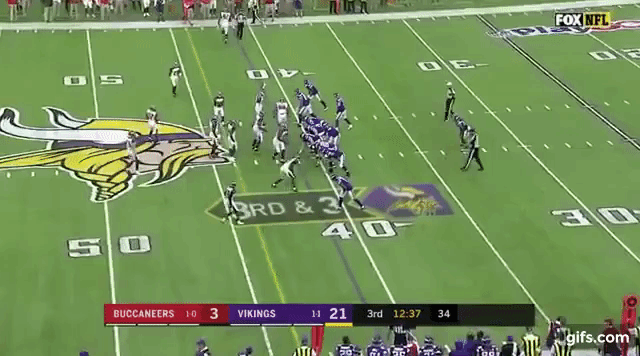
Of course, play action isn’t a possibility on third-and-long, when it’s obvious the offense has to pass the ball. With a less-than-stellar pass blocking offensive line in Minnesota a year ago, and here in Denver, such situations become especially tricky.
Regardless of how good Keenum was a season ago under pressure—and he was the best QB in the NFL—it’s one thing to be able to make a play and complete a short throw with pressure bearing down, and entirely another to be able to fling the ball deep to the sticks to make a play.
Keenum can make plays deep, but he needs to be unpredictable. If the defense expects those types of passes, he’s just not physically gifted enough to consistently make throws downfield.
Another thing that’s noticeable on tape is Keenum’s propensity to take check downs and not force things on third down. This might be maddening at times, and might remind some fans of Trevor Siemian, but he wasn’t a huge gambler in 2017 with the Vikings, which is a big part of why his percentages weren’t better on third-and-long.
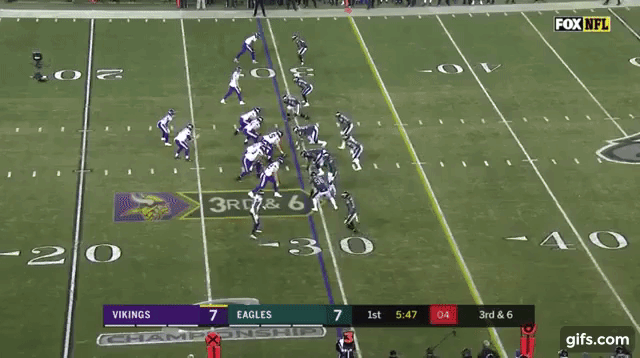
We noted in our previous film room how Keenum can sometimes take too many risks and how he needs to be cognizant of not regressing to his gunslinger mentality. He did a good job of this last season, which was a big part of his success. However, thrusting him in situations where he needs to make big plays to succeed could really complicate his approach and cause him to regress.
Essentially, Keenum’s strengths are his IQ, ability to throw accurately with anticipation, and his poise under pressure. All areas that can serve him well on third down, where Denver was not good a year ago.
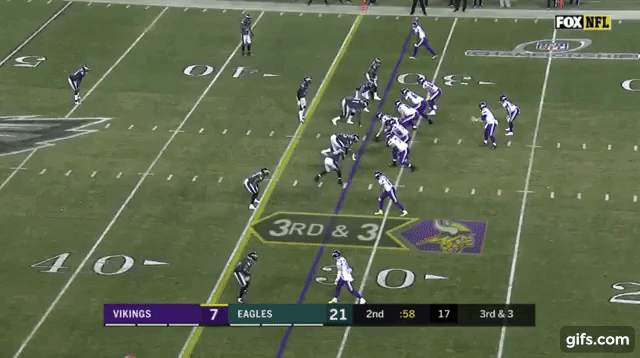
His weakness is first and foremost his arm strength. In situations where he needs to stand tough and sling it, he’s at a disadvantage, which is why it’s so key to keep him out of third-and-long situations.
If forced into too many long down-and-distance situations, the Broncos risk setting Keenum up for failure and seeing him struggle like he did against the Philadelphia Eagles in the NFC Championship game, who essentially were able to just tee-off on Keenum as the game progressed.
The impact of the run game and offensive line
The running game plays a big part in all of this, by limiting third-and-long situations altogether. Last season, the Vikings were the NFL’s seventh-best team in total rushing yards and were second to only the Jacksonville Jaguars in rushing attempts. Those numbers, on the surface, look really enticing. When you dig deeper, though, the Vikings rushed for fewer yards per carry than Denver in 2017, racking up only 3.9 yards on average.
Sticking to that run game was essential for Minnesota in letting Keenum do his thing on third-and-manageable, which was a big part of why their QB was able to perform so well.
That means a few things for the Broncos. First and foremost, they’ll have to practice what they preach and truly be a run-first, ground-control type offense. That’s what’ll be best for Keenum, even if the run game isn’t spectacular like it was in Minnesota.
Another comforting sign for Keenum’s transition to Denver is that the Broncos line actually outperformed the Vikings in most metrics when it came to run blocking, per Football Outsiders, this past season. If the Broncos performed above league average in run blocking last year, with a new veteran addition in Jared Veldheer and improvements from the young guys like Garett Bolles, plus a full bill of health from Ronald Leary, the line should improve significantly.
Keeping a commitment to the run will also open up play action plays, an area in which Keenum performed very well last season.
Another aspect of this that can’t be neglected is avoiding penalties, especially on the offensive line, where flags for holding and false starts killed drives regularly last season. That’s something the diminutive veteran gunslinger won’t be able to overcome given his weaknesses. A disciplined and balanced approach is paramount.
In conclusion
Keenum is far from perfect, but his strengths line up pretty well with Denver’s offense. The narrative that improved pass protection is needed from the tackle spots is somewhat overrated given what the Vikings former quarterback did a year ago with similarly “talented” pass protection. It might seem counterintuitive, but this quarterback needs good run blocking more than he does sound pass protection, especially if the scheme in place is based on quick-hitting throws.
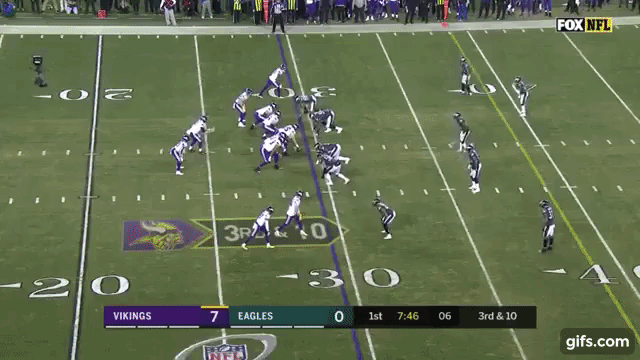
Comments
Share your thoughts
Join the conversation




